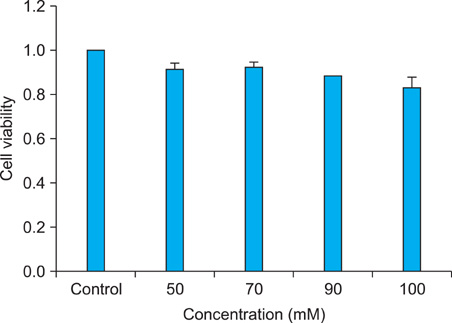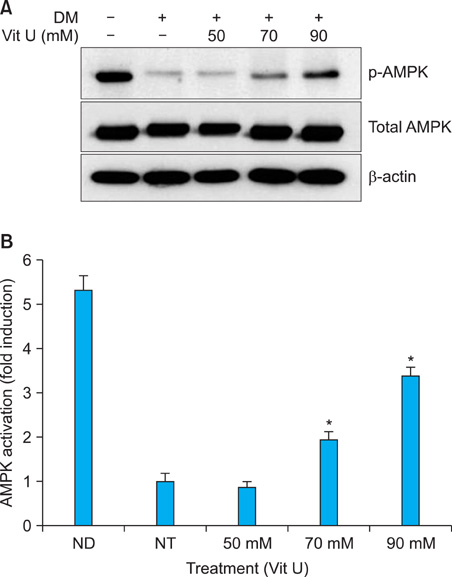Ann Dermatol.
2012 Feb;24(1):39-44. 10.5021/ad.2012.24.1.39.
Inhibitory Effect of Vitamin U (S-Methylmethionine Sulfonium Chloride) on Differentiation in 3T3-L1 Pre-adipocyte Cell Lines
- Affiliations
-
- 1Arumdaun Nara Skin Clinic, Seoul, Korea.
- 2Department of Pathology, Chung-Ang University College of Medicine, Seoul, Korea. sky@cau.ac.kr
- 3Department of Dermatology, Chung-Ang University College of Medicine, Seoul, Korea.
- KMID: 2156854
- DOI: http://doi.org/10.5021/ad.2012.24.1.39
Abstract
- BACKGROUND
S-methylmethionine sulfonium chloride was originally called vitamin U because of its inhibition of ulceration in the digestive system. Vitamin U is ubiquitously expressed in the tissues of flowering plants, and while there have been reports on its hypolipidemic effect, its precise function remains unknown.
OBJECTIVE
This study was designed to evaluate the anti-obesity effect of vitamin U in 3T3-L1 pre-adipocyte cell lines.
METHODS
We cultured the pre-adipocyte cell line 3T3L1 to overconfluency and then added fat differentiation-inducing media (dexamethasone, IBMX [isobutylmethylxanthine], insulin, indomethacin) and different concentrations (10, 50, 70, 90, 100 mM) of vitamin U. Then, we evaluated changes in the levels of triglycerides (TGs), glycerol-3-phosphate dehydrogenase (G3PDH), AMP-activated protein kinase (AMPK), adipocyte-specific markers (peroxisome proliferator-activated receptor gamma [PPAR-gamma], CCAAT/enhancer-binding protein alpha [C/EBP-alpha], adipocyte differentiation and determination factor 1 [ADD-1], adipsin, fatty acid synthase, lipoprotein lipase) and apoptosis-related signals (Bcl-2, Bax).
RESULTS
There was a gradual decrease in the level of TGs, C/EBP-alpha, PPAR-gamma, adipsin, ADD-1 and GPDH activity with increasing concentrations of vitamin U. In contrast, we observed a significant increase in AMPK activity with increasing levels of vitamin U. The decrease in bcl-2 and increase in Bax observed with increasing concentrations of vitamin U in the media were not statistically significant.
CONCLUSION
This study suggests that vitamin U inhibits adipocyte differentiation via down-regulation of adipogenic factors and up-regulation of AMPK activity.
MeSH Terms
-
1-Methyl-3-isobutylxanthine
Adipocytes
AMP-Activated Protein Kinases
Cell Line
Complement Factor D
Digestive System
Down-Regulation
Fatty Acid Synthetase Complex
Flowers
Glycerolphosphate Dehydrogenase
Insulin
Lipoproteins
Triglycerides
Ulcer
Up-Regulation
Vitamin U
Vitamins
1-Methyl-3-isobutylxanthine
AMP-Activated Protein Kinases
Complement Factor D
Fatty Acid Synthetase Complex
Glycerolphosphate Dehydrogenase
Insulin
Lipoproteins
Triglycerides
Vitamin U
Vitamins
Figure
Reference
-
1. Spiegelman BM, Flier JS. Obesity and the regulation of energy balance. Cell. 2001. 104:531–543.
Article2. Spiegelman BM, Hu E, Kim JB, Brun R. PPAR gamma and the control of adipogenesis. Biochimie. 1997. 79:111–112.3. Tontonoz P, Hu E, Spiegelman BM. Stimulation of adipogenesis in fibroblasts by PPAR gamma 2, a lipid-activated transcription factor. Cell. 1994. 79:1147–1156.
Article4. Umek RM, Friedman AD, McKnight SL. CCAAT-enhancer binding protein: a component of a differentiation switch. Science. 1991. 251:288–292.
Article5. Yeh WC, Cao Z, Classon M, McKnight SL. Cascade regulation of terminal adipocyte differentiation by three members of the C/EBP family of leucine zipper proteins. Genes Dev. 1995. 9:168–181.
Article6. Kim JB, Spiegelman BM. ADD1/SREBP1 promotes adipocyte differentiation and gene expression linked to fatty acid metabolism. Genes Dev. 1996. 10:1096–1107.
Article7. Ranganathan G, Unal R, Pokrovskaya I, Yao-Borengasser A, Phanavanh B, Lecka-Czernik B, et al. The lipogenic enzymes DGAT1, FAS, and LPL in adipose tissue: effects of obesity, insulin resistance, and TZD treatment. J Lipid Res. 2006. 47:2444–2450.
Article8. Friedman JM, Halaas JL. Leptin and the regulation of body weight in mammals. Nature. 1998. 395:763–770.
Article9. Rosen BS, Cook KS, Yaglom J, Groves DL, Volanakis JE, Damm D, et al. Adipsin and complement factor D activity: an immune-related defect in obesity. Science. 1989. 244:1483–1487.
Article10. Hotamisligil GS, Shargill NS, Spiegelman BM. Adipose expression of tumor necrosis factor-alpha: direct role in obesity-linked insulin resistance. Science. 1993. 259:87–91.
Article11. Ahima RS, Flier JS. Adipose tissue as an endocrine organ. Trends Endocrinol Metab. 2000. 11:327–332.
Article12. Sartipy P, Loskutoff DJ. Monocyte chemoattractant protein 1 in obesity and insulin resistance. Proc Natl Acad Sci USA. 2003. 100:7265–7270.13. Hardie DG, Scott JW, Pan DA, Hudson ER. Management of cellular energy by the AMP-activated protein kinase system. FEBS Lett. 2003. 546:113–120.
Article14. Fryer LG, Carling D. AMP-activated protein kinase and the metabolic syndrome. Biochem Soc Trans. 2005. 33:362–366.
Article15. Kahn BB, Alquier T, Carling D, Hardie DG. AMP-activated protein kinase: ancient energy gauge provides clues to modern understanding of metabolism. Cell Metab. 2005. 1:15–25.
Article16. Roche-VITEC . Vitamin U. Pig News Info. 1990. 11:329–330.17. Gessler NN, Kharchenko LI, Pavlovskaia TE, Bykhovskiĭ VIa. Radiation-protective effect of S-methylmethionine (vitamin U). Prikl Biokhim Mikrobiol. 1996. 32:666–668.18. Tomiyama K, Nakata H, Sasa H, Arimura S, Nishio E, Watanabe Y. Wortmannin, a specific phosphatidylinositol 3-kinase inhibitor, inhibits adipocytic differentiation of 3T3-L1 cells. Biochem Biophys Res Commun. 1995. 212:263–269.
Article19. Towler MC, Hardie DG. AMP-activated protein kinase in metabolic control and insulin signaling. Circ Res. 2007. 100:328–341.
Article20. Dolinsky VW, Dyck JR. Role of AMP-activated protein kinase in healthy and diseased hearts. Am J Physiol Heart Circ Physiol. 2006. 291:H2557–H2569.
Article21. Hwang JT, Park IJ, Shin JI, Lee YK, Lee SK, Baik HW, et al. Genistein, EGCG, and capsaicin inhibit adipocyte differentiation process via activating AMP-activated protein kinase. Biochem Biophys Res Commun. 2005. 338:694–699.
Article
- Full Text Links
- Actions
-
Cited
- CITED
-
- Close
- Share
- Similar articles
-
- Effect of Dexamethasone, Retinoid Acid and Vitamin D on the Transdifferentiation of 3T3-L1 and KS483
- The Effects of Epigallocatechin on Adipogenesis of 3T3-L1 Preadipocytes
- Effects of (6)-gingerol, ginger component on adipocyte development and differentiation in 3T3-L1
- Anti-obesity effect of EGCG and glucosamine-6-phosphate through decreased expression of genes related to adipogenesis and cell cycle arrest in 3T3-L1 adipocytes
- TonEBP suppresses adipocyte differentiation via modulation of early signaling in 3T3-L1 cells





